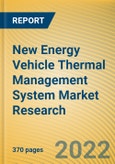Thermal Management Research: Technological Innovation and Iteration Have Spawned Emerging Markets
The rapid development of Chinese new energy vehicles has brought more opportunities for parts and components. Chinese enterprises, such as Sanhua Intelligent Controls, Zhejiang Yinlun Machinery, Aotecar, Tuopu Group, etc., have been actively deploying new energy thermal management in recent years. They have obtained orders from emerging automakers, domestic and foreign OEMs and other new energy vehicle companies for thermal management products, and made a breakthrough in the core technology of new energy vehicles.Market and Technology Trends of System Components
`New Energy Vehicle Thermal Management System Market Research Report, 2022` released by the publisher summarizes and analyzes top 12 providers of new energy vehicle thermal management system integration solutions, top 10 suppliers of heat pump air conditioners, top 10 suppliers of electric compressors, top 10 suppliers of electronic water pumps, top 7 suppliers of battery thermal management systems, top 6 suppliers of thermal management system piping, top 5 suppliers of heat exchangers, and top 4 suppliers of electronic expansion valves.Development Trend 1: Heat Pump Air Conditioning System
The heat pump system represents a clear development direction for thermal management of new energy vehicles. More and more models adopt heat pumps which can realize comprehensive energy utilization for new energy vehicles. In the future, the heat pump system will develop towards integration and modularization.Development Trend 2: Refrigerant Technology Routes
With the steady advancement of environmental protection policies, the replacement of R-134a has become inevitable, but automakers have different opinions on choosing R-1234yf or CO(2) as refrigerant.DuPont and Honeywell developed R-1234yf jointly and applied for a production process patent for it, which means the use of the technology requires a patent fee. American automakers like GM, Ford, etc., as well as French automakers like PSA, etc. adopt R-1234yf.
In addition to Eco-friendly and heat pump performance, CO(2) is relatively safer because it is not flammable while R-1234yf is moderately flammable. German automakers like Daimler, Volkswagen, BMW, etc. prefer CO(2).
Evolution of Heat Pump Air Conditioning Refrigerant Technology
Development Trend 3: Electric Compressors
With the development of new energy vehicles, almost all automotive air-conditioning compressor companies are aggressively transferring to electric compressors. Since electric compressors have a short history as emerging components, most players are standing on the same starting line. With increasing market demand, electric compressor takes relatively tight capacity and is in short supply.Emerging enterprises: As the sales volume of new energy vehicles escalates, thermal management industry has seen a boarder market space, and a large number of enterprises including conventional white goods enterprises (such as Hisense, Gree, Midea, etc.) and new energy vehicle companies have flocked to electric compressor industry. However, it is not easy for conventional white goods companies to dabble in the field of automotive air conditioning. Nowadays, there is no outstanding Chinese air conditioner brand that excels in automotive air conditioners and air conditioner compressors.
New technology routes: The current novel technology routes for electric compressors include:
- R744 (CO2) compressors (R744 ultra-low-temperature heat pump compressors of Shanghai EVERLAND AMPEREX)
- Air-enhancing enthalpy compressors (air-enhancing enthalpy compressors of Aotecar and Shanghai EVERLAND AMPEREX)
- 800V electric compressors (Brose’s 800V/55cc electronic air conditioner compressors, MAHLE’s 800V 57cc electric compressors), etc.
Technical Architecture and Trends of OEM Thermal Management Systems
The automotive thermal management system controls heat of entire vehicle to ensure that the occupants, batteries, motors, and other components are all within a comfortable temperature environment. New energy vehicles have higher requirements for thermal management, so that the cost herein is about three times that of fuel vehicles. New energy vehicles not only add battery thermal management systems, but also require product replacement and upgrades. Moreover, new energy vehicle components are more sensitive to temperature, so there are higher requirements for components and more detailed requirements for the coordination of all components.Under such circumstances, new energy vehicle OEMs have launched their own unique thermal management system solutions, dominating the development of thermal management solutions and featuring significant customization.
For example, BYD's latest e-platform 3.0 enables heat pump integration. Under the architecture of e-platform 3.0, the integrated thermal management system no longer simply integrates cockpit air conditioning system and blade battery thermal management system.
In terms of design concept, the thermal management system is similar to Tesla's integrated valve island solution, which integrates refrigerant circuit on a large scale. The valve island structure integrates most control components of refrigerant circuit, and divides them into electric compressors, front-end modules, thermal management integrated modules, in-vehicle condensers and evaporators, which are controlled by software through electric drive system.
Under e-platform 3.0 architecture, the integrated thermal management system based on BC series heat pump air conditioning reduces energy loss, conducts the interaction of cooling and heat around cockpit and power battery, makes BYD OS control domains, sends cooling directly to blade battery and cockpit, and allows heat to be transferred between electric drive system, cockpit and blade battery.
This product will be delivered within 3-5 business days.
Table of Contents
1 Introduction and Policy of New Energy Vehicle Thermal Management System
2 Current Situation and Trend of New Energy Vehicle Thermal Management Market
3 Analysis of New Energy Vehicle Thermal Management Industry Chain
4 New Energy Vehicle Thermal Management System Suppliers
5 OEM Thermal Management System Solution
Companies Mentioned
- Denso
- MAHLE
- Valeo
- Hanon
- Sanden Corporation
- Continental
- Aotecar
- Yinlun Machinery
- Sanhua Intelligent Controls
- Songz Automobile Air Conditioning
- HASCO
- Tenglong Auto Parts
- Feilong Auto Components
- Kelai
- Dun'an Artificial Environment
- Midea Welling Car
- Baling Technology
- Huawei
- Zhongding
- Tesla
- BYD
- Volkswagen
- NIO
- SAIC Group
- Geely
- Li Auto
- Xpeng
- WM
- Audi
- BMW
- SAIC-GM
- Hyundai Motor
Methodology

LOADING...








